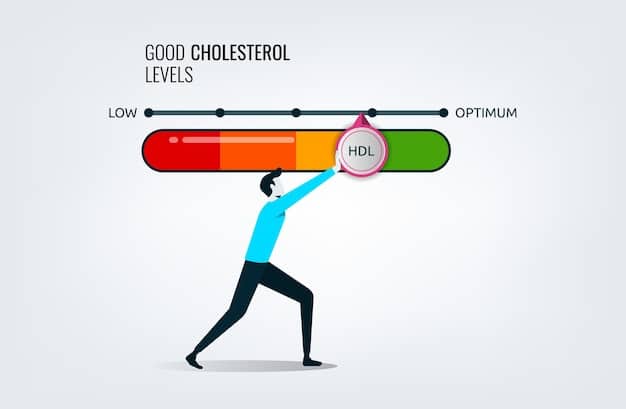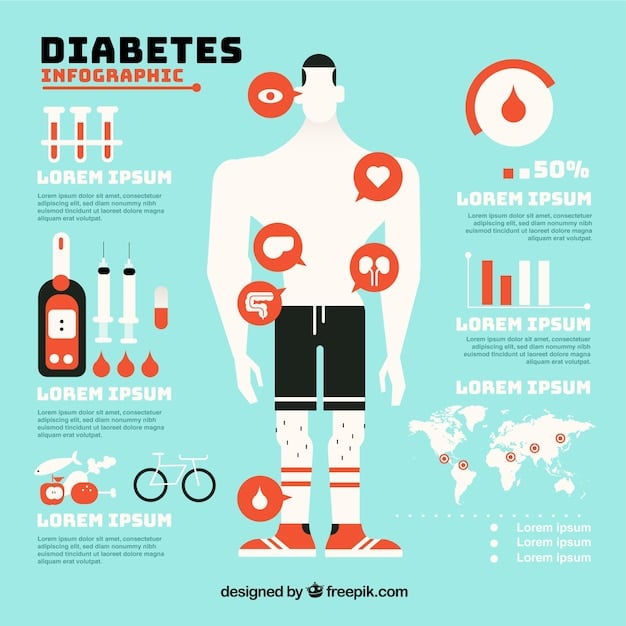Intermittent Fasting 16/8: 3-Month Progress & Effectiveness

The 16/8 intermittent fasting method continues to show considerable effectiveness after three months for many individuals, promoting weight management, metabolic health, and increased energy, though individual results and optimal implementation may vary based on personal circumstances and consistency.
In the evolving landscape of health and wellness, Intermittent Fasting: Is the 16/8 Method Still Effective? A 3-Month Progress Report seeks to cut through the noise, offering an in-depth look at what happens when you commit to this popular eating pattern for a quarter of a year. Many embark on intermittent fasting with high hopes, but how does it truly fare beyond the initial novelty? We delve into the reported benefits, challenges, and the sustained impact of the 16/8 approach, providing a nuanced perspective for those considering or currently practicing this dietary strategy.
Understanding the 16/8 Intermittent Fasting Method
The 16/8 intermittent fasting method stands out as one of the most popular and accessible approaches to time-restricted eating. Its simplicity is a key factor in its widespread adoption, making it a sustainable strategy for many looking to improve their health. At its core, the 16/8 method involves fasting for 16 hours each day and confining all food intake to an 8-hour window.
For example, if you finish dinner at 8 p.m., your next meal wouldn’t be until 12 p.m. the following day. This pattern naturally skips breakfast for many, aligning well with busy schedules. During the fasting period, plain water, black coffee, and unsweetened tea are generally permitted, as they contain negligible calories and therefore do not break the fast.
The science behind the simplicity
The appeal of 16/8 isn’t just convenience; it’s rooted in the body’s metabolic response to periods of food deprivation. When you fast, your body depletes its immediate glucose stores and begins to tap into fat reserves for energy, a process known as metabolic switching. This shift can lead to several physiological changes.
- Autophagy: A cellular cleansing process where the body removes damaged cells and regenerates new ones.
- Insulin sensitivity: Improved ability of cells to respond to insulin, potentially reducing the risk of type 2 diabetes.
- Human Growth Hormone (HGH) release: Fasting can stimulate HGH production, which plays a role in fat loss and muscle gain.
These internal mechanisms contribute to the perceived benefits of intermittent fasting beyond simple calorie restriction. It’s not just about eating less, but about promoting specific cellular and hormonal functions that support overall health.
The long-term adherence to this method often depends on an individual’s lifestyle and dietary choices within the eating window. It emphasizes the timing of meals rather than restricting specific foods, offering flexibility that can be appealing. However, the quality of food consumed during the eating window remains paramount for achieving optimal health outcomes and sustaining energy levels throughout the fasting period.
This method positions itself as a lifestyle rather than a diet, encouraging participants to listen to their bodies and adjust their eating schedules as needed. Its adaptability is a major reason for its continued relevance and effectiveness for many after several months.
Initial Expectations vs. 3-Month Reality: What Changes?
When individuals first embark on the 16/8 intermittent fasting journey, they often come with a set of expectations, largely influenced by testimonials and readily available information. Common initial hopes include rapid weight loss, increased energy, and better focus. However, the true test of any dietary pattern comes with sustained commitment, and a 3-month mark provides a realistic snapshot of its ongoing impact.
The first few weeks typically involve an adjustment period as the body adapts to new eating times. Many experience initial weight loss, often due to a natural reduction in overall calorie intake and the shedding of water weight. Energy levels can fluctuate, with some reporting an initial dip followed by a surge, while mental clarity often becomes more pronounced as the body adjusts to burning fat for fuel.
Beyond the honeymoon phase
As the 3-month mark approaches, the “honeymoon phase” of rapid changes might subside, giving way to more subtle but potentially more significant transformations. This is where the long-term effectiveness of the 16/8 method truly reveals itself. Sustained weight management, rather than dramatic drops, becomes a key indicator of success.
- Stabilized energy levels: Most fasters report consistent energy throughout the day, avoiding the typical afternoon slumps.
- Improved digestion: Many find their digestive system becomes more regulated, possibly due to longer periods of rest for the gut.
- Enhanced body composition: Beyond scale numbers, some observe shifts in muscle-to-fat ratio, even without explicit exercise changes.
The critical difference between initial expectations and the 3-month reality often lies in the sustainability of the routine. Those who see continued positive results usually integrate the 16/8 method seamlessly into their daily lives, viewing it less as a restrictive diet and more as a natural eating rhythm. Challenges often arise when adherence wavers or when the types of food consumed during the eating window are not nutritionally dense.

Moreover, the psychological aspect plays a significant role. Initial enthusiasm can give way to boredom or the temptation of breaking the fast. However, for those who push through, the routine often becomes second nature, transforming from a conscious effort into an ingrained habit. This transition is crucial for long-term effectiveness and demonstrates that the 16/8 method can indeed be a sustainable lifestyle choice rather than a temporary fix.
Weight Management: Is 16/8 Still Delivering Results?
For many, the primary motivation for adopting the 16/8 intermittent fasting method is weight management, particularly fat loss. After 3 months, the question of whether this approach continues to deliver tangible results becomes highly pertinent. While initial weight loss can be substantial due to reduced calorie intake and water weight fluctuations, sustained progress hinges on consistent adherence and realistic expectations.
At the 3-month mark, individuals often report a continued, albeit possibly slower, decline in weight, especially if they are also incorporating a balanced diet within their eating window and some form of physical activity. The method’s effectiveness in weight management stems from several factors beyond just calorie restriction.
How sustained fasting aids fat loss
The extended fasting period allows insulin levels to drop and stay low for longer, which is crucial for fat burning. When insulin is high, the body is in a fat-storing state. By providing longer windows of low insulin, 16/8 encourages the body to switch to fat for fuel. This metabolic flexibility is a significant advantage over continuous grazing throughout the day.
- Reduced snacking: Confining food intake to an 8-hour window naturally limits opportunities for mindless snacking, particularly on high-calorie, low-nutrient foods.
- Calorie deficit: For many, the shortened eating window leads to an unintentional reduction in total daily calories, a fundamental principle of weight loss.
- Increased fat oxidation: The body becomes more efficient at burning stored fat for energy during fasting periods.
However, it’s vital to acknowledge that 16/8 is not a license to overeat unhealthy foods during the eating window. Consuming excessive amounts of processed foods, sugary drinks, or calorie-dense meals can negate the benefits of fasting. Sustainable weight loss with 16/8 requires a mindful approach to nutrition, prioritizing whole, unprocessed foods.
Moreover, plateaus can occur. The human body is remarkably adaptable, and over time, it may adjust to the fasting routine, slowing down weight loss. This is where incorporating variations, optimizing food choices, and perhaps integrating strength training can help to reignite progress. A 3-month report on weight management often shows a stabilization of weight within a healthier range, rather than a continuous downward spiral, which can be a positive sign of long-term sustainability and metabolic balance.
Metabolic Health Markers and Energy Levels: A 3-Month Check-Up
Beyond the visible changes like weight loss, the true efficacy of the 16/8 intermittent fasting method often lies in its impact on underlying metabolic health markers and daily energy levels. After three months, these internal shifts can become more pronounced, offering a deeper understanding of the method’s long-term benefits.
Many individuals report significant improvements in how they feel overall, attributing it to a more stable metabolism. Blood sugar levels tend to stabilize, reducing the spikes and crashes associated with continuous eating. This can lead to a more consistent energy output throughout the day, eliminating the dreaded afternoon slump that often prompts unhealthy snacking.
Deep dive into metabolic benefits
The metabolic advantages of 16/8 fasting, particularly after a sustained period, extend beyond simple glucose regulation. Research and anecdotal evidence suggest a positive influence on several key indicators of metabolic health.
- Improved insulin sensitivity: Cells become more responsive to insulin, requiring less hormone to transport glucose, which is crucial for preventing insulin resistance and type 2 diabetes.
- Reduced inflammation: Fasting periods seem to lower systemic inflammation, a contributing factor to numerous chronic diseases.
- Better cholesterol profiles: Some studies indicate improvements in lipid profiles, including reductions in LDL (bad) cholesterol and triglycerides.
These internal adaptations translate into tangible benefits for the dieter. Waking up feeling more refreshed, experiencing fewer cravings, and maintaining mental clarity are commonly reported after three months. The body learns to efficiently switch between burning carbohydrates and fats for energy, leading to greater metabolic flexibility. This adaptability contributes significantly to sustained energy levels, as the body isn’t constantly reliant on external food intake for fuel.

However, individual responses can vary based on genetics, existing health conditions, and the quality of food consumed during the eating window. While 16/8 can promote metabolic health, integrating nutrient-dense foods is paramount. A fasting regimen is not a magic bullet; it works best when combined with a holistic approach to diet and lifestyle. The 3-month review typically reveals that the majority of consistent fasters experience a positive trajectory in both their metabolic health and their daily vitality.
Challenges and Staying Consistent Over 3 Months
While the 16/8 intermittent fasting method offers numerous benefits, sustaining consistency over a 3-month period is often where the true challenge lies. Initial enthusiasm can wane, and the realities of daily life – social events, work stress, and plain old hunger – can test one’s resolve. Understanding these common hurdles and developing strategies to overcome them is crucial for long-term adherence and effectiveness.
One of the most frequently reported challenges in the early stages is dealing with hunger pangs, especially if one is accustomed to regular meals or snacking throughout the day. This typically subsides as the body adapts, but unexpected cravings or emotional eating can still derail progress.
Navigating common hurdles to consistency
Beyond initial hunger, other practical and psychological barriers often emerge as the months progress. Being prepared for these can make a significant difference in maintaining the routine.
- Social pressures: Dining out with friends or family where meal timings don’t align can be difficult to navigate without feeling socially isolated or explaining one’s fasting routine.
- Work schedule conflicts: Irregular shifts or demanding work environments might make it harder to stick to a strict 8-hour eating window.
- Fatigue or low energy: Some individuals, especially early on or if nutritionally deficient, might experience temporary dips in energy or a feeling of sluggishness.
- Nutrient deficiencies: If the eating window is used for consuming highly processed or nutrient-poor foods, the body can miss out on essential vitamins and minerals, leading to overall fatigue and poor health outcomes.
To stay consistent, adaptability is key. Instead of viewing the 16/8 schedule as rigid, consider it a flexible framework. If a social event falls outside your usual eating window, adjusting your fasting period for that day is often preferable to abandoning the method entirely. Hydration is also paramount, as plain water, black coffee, and unsweetened tea can help manage hunger during the fasting hours.
Building a supportive environment, communicating your dietary choices to close ones, and focusing on nutrient-dense foods during your eating window can significantly enhance adherence. Celebrating small victories and reminding oneself of the positive changes experienced can also boost motivation. By the 3-month mark, those who successfully navigate these challenges often feel a strong sense of accomplishment and find the routine has become a normal, effortless part of their day, indicating its sustainable effectiveness.
Optimizing 16/8 for Sustained Success and Beyond
Reaching the 3-month mark with 16/8 intermittent fasting is a significant achievement, signaling that the method can be a sustainable part of one’s lifestyle. However, to ensure continued benefits and avoid plateaus, simply adhering to the 16/8 schedule might not be enough. Optimizing the approach involves thoughtful consideration of dietary choices, exercise, and listening to the body’s evolving needs.
The quality of food consumed during the 8-hour eating window is paramount. While 16/8 focuses on timing, it doesn’t grant a free pass to indulge in unhealthy eating. For sustained success, the eating window should be filled with nutrient-dense, whole foods that provide adequate protein, healthy fats, complex carbohydrates, and essential micronutrients.
Strategies for long-term efficacy
To keep the positive momentum going and even enhance the benefits after three months, consider these optimization strategies:
- Prioritize nutrient density: Focus on whole, unprocessed foods like lean proteins, plenty of vegetables, fruits, healthy fats (avocados, nuts, olive oil), and complex carbohydrates (whole grains, sweet potatoes).
- Stay hydrated: Continue to drink plenty of water, and electrolyte-rich fluids (without breaking the fast) during both fasting and eating windows. Proper hydration is critical for energy and metabolic function.
- Incorporate exercise: Combine your fasting routine with regular physical activity. Strength training can help preserve muscle mass, while cardiovascular exercise can further enhance fat burning and metabolic health.
- Listen to your body: Pay attention to hunger signals, energy levels, and overall well-being. If you consistently feel low on energy or experience negative side effects, it may be a sign to adjust your fasting schedule, food choices, or consult with a healthcare professional.
- Vary your fasting periods: While 16/8 is consistent, occasionally extending a fast (e.g., 18:6 or 20:4) or having a day without fasting can keep the body from fully adapting and prevent plateaus. This is often referred to as “fasting variation.”
Another important aspect is mindfulness. Eating slowly, savoring your meals, and paying attention to satiety cues can prevent overeating during the limited eating window. This not only supports weight management but also enhances the enjoyment of food and digestive health.
Ultimately, optimizing 16/8 for sustained success transforms it from a “diet” into a sustainable lifestyle where well-being is continually supported. It’s about empowering the body to work efficiently, leveraging the benefits of time-restricted eating to promote an overall healthier and more energetic life beyond the 3-month milestone.
| Key Aspect | Brief Description |
|---|---|
| ⚖️ Weight Management | Sustained, often gradual weight loss. Focus shifts to maintenance and body composition. |
| ⚡ Energy & Focus | Improved stable energy levels and enhanced mental clarity are common after adaptation. |
| 🩺 Metabolic Health | Better insulin sensitivity, reduced inflammation, and potentially improved lipid profiles. |
| 💪 Consistency | Challenges like social pressure and hunger diminish with effective coping strategies and adaptation. |
Frequently Asked Questions About 16/8 Fasting
▼
While generally safe for most healthy adults, 16/8 intermittent fasting is not suitable for everyone. Pregnant or breastfeeding women, individuals with a history of eating disorders, those with type 1 diabetes, or people on certain medications should avoid it or consult a healthcare professional before starting. Always listen to your body and seek medical advice for personalized guidance, especially if you have underlying health conditions.
▼
During the 16-hour fasting window, it is permissible to consume plain water, black coffee, unsweetened tea, and plain sparkling water. These beverages contain negligible calories and therefore do not break your fast. Avoid adding sugar, milk, cream, or artificial sweeteners, as these can trigger an insulin response and negate the metabolic benefits of fasting. Staying well-hydrated is crucial for managing hunger and maintaining electrolyte balance.
▼
Concerns about muscle loss are common with fasting, but studies suggest that with proper protein intake during your eating window and regular resistance training, muscle mass can be preserved or even increased. Intermittent fasting may even promote Human Growth Hormone (HGH) release, which supports muscle maintenance and growth. Prioritizing strength training and adequate protein is key to preventing muscle degradation while fasting.
▼
To maximize the benefits of 16/8 intermittent fasting, focus on nutrient-dense whole foods during your 8-hour eating window. This includes lean proteins (chicken, fish, eggs, legumes), healthy fats (avocados, nuts, olive oil), complex carbohydrates (whole grains, vegetables, fruits), and plenty of fiber. Prioritizing these foods ensures you receive essential vitamins, minerals, and energy, supporting overall health and satiety while complementing your fasting efforts.
▼
While some individuals experience immediate benefits like weight loss and improved energy within the first few weeks, significant and sustained results often become more apparent after 1-3 months of consistent adherence. The body needs time to adapt to new eating patterns and optimize metabolic processes. Results vary widely based on individual factors like starting weight, diet quality, exercise, and overall health status, emphasizing that consistency is more important than speed.
Conclusion
The 3-month progress report on the 16/8 intermittent fasting method reveals a robust and often sustainable approach to health and wellness. While initial experiences may involve adaptation challenges, consistent adherence frequently leads to tangible benefits beyond just weight loss, encompassing improved metabolic markers, stabilized energy levels, and enhanced mental clarity. The effectiveness of 16/8 isn’t merely a transient phenomenon; for many, it evolves into an integral part of a balanced lifestyle, provided it’s paired with mindful nutritional choices and a responsive attitude to individual bodily needs. This sustained positive impact underscores the 16/8 method’s continued relevance and efficacy in the realm of healthy eating practices.





